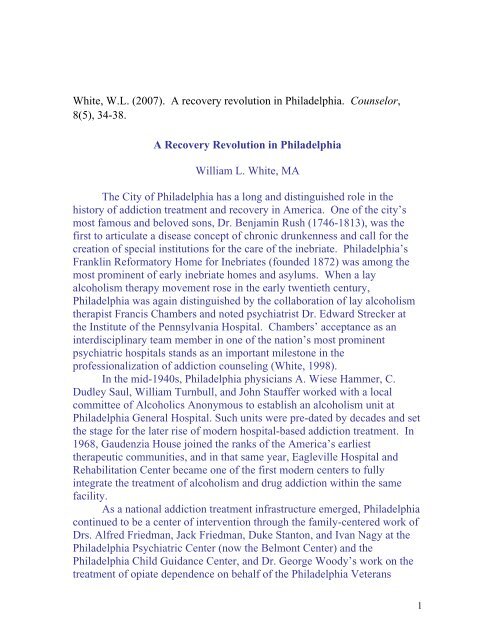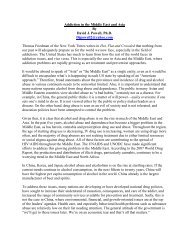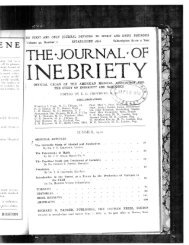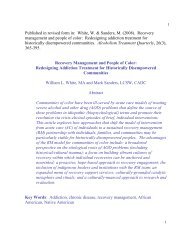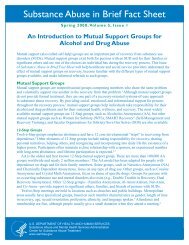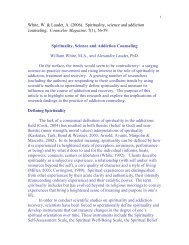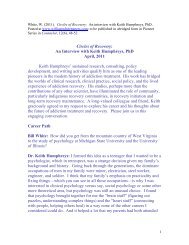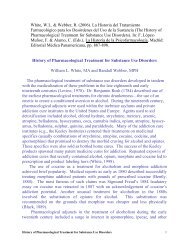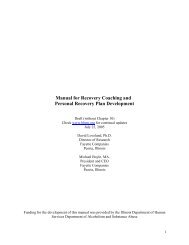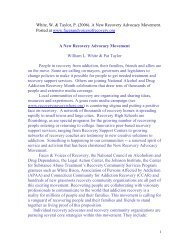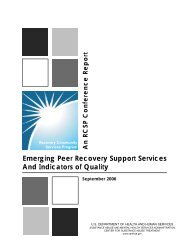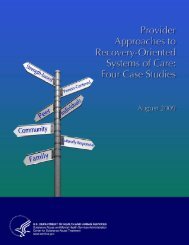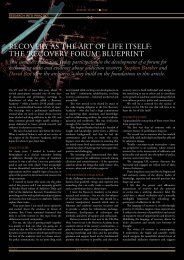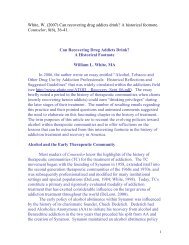A Recovery Revolution in Philadelphia - William L. White
A Recovery Revolution in Philadelphia - William L. White
A Recovery Revolution in Philadelphia - William L. White
Create successful ePaper yourself
Turn your PDF publications into a flip-book with our unique Google optimized e-Paper software.
<strong>White</strong>, W.L. (2007). A recovery revolution <strong>in</strong> <strong>Philadelphia</strong>. Counselor,8(5), 34-38.A <strong>Recovery</strong> <strong>Revolution</strong> <strong>in</strong> <strong>Philadelphia</strong><strong>William</strong> L. <strong>White</strong>, MAThe City of <strong>Philadelphia</strong> has a long and dist<strong>in</strong>guished role <strong>in</strong> thehistory of addiction treatment and recovery <strong>in</strong> America. One of the city’smost famous and beloved sons, Dr. Benjam<strong>in</strong> Rush (1746-1813), was thefirst to articulate a disease concept of chronic drunkenness and call for thecreation of special <strong>in</strong>stitutions for the care of the <strong>in</strong>ebriate. <strong>Philadelphia</strong>’sFrankl<strong>in</strong> Reformatory Home for Inebriates (founded 1872) was among themost prom<strong>in</strong>ent of early <strong>in</strong>ebriate homes and asylums. When a layalcoholism therapy movement rose <strong>in</strong> the early twentieth century,<strong>Philadelphia</strong> was aga<strong>in</strong> dist<strong>in</strong>guished by the collaboration of lay alcoholismtherapist Francis Chambers and noted psychiatrist Dr. Edward Strecker atthe Institute of the Pennsylvania Hospital. Chambers’ acceptance as an<strong>in</strong>terdiscipl<strong>in</strong>ary team member <strong>in</strong> one of the nation’s most prom<strong>in</strong>entpsychiatric hospitals stands as an important milestone <strong>in</strong> theprofessionalization of addiction counsel<strong>in</strong>g (<strong>White</strong>, 1998).In the mid-1940s, <strong>Philadelphia</strong> physicians A. Wiese Hammer, C.Dudley Saul, <strong>William</strong> Turnbull, and John Stauffer worked with a localcommittee of Alcoholics Anonymous to establish an alcoholism unit at<strong>Philadelphia</strong> General Hospital. Such units were pre-dated by decades and setthe stage for the later rise of modern hospital-based addiction treatment. In1968, Gaudenzia House jo<strong>in</strong>ed the ranks of the America’s earliesttherapeutic communities, and <strong>in</strong> that same year, Eagleville Hospital andRehabilitation Center became one of the first modern centers to fully<strong>in</strong>tegrate the treatment of alcoholism and drug addiction with<strong>in</strong> the samefacility.As a national addiction treatment <strong>in</strong>frastructure emerged, <strong>Philadelphia</strong>cont<strong>in</strong>ued to be a center of <strong>in</strong>tervention through the family-centered work ofDrs. Alfred Friedman, Jack Friedman, Duke Stanton, and Ivan Nagy at the<strong>Philadelphia</strong> Psychiatric Center (now the Belmont Center) and the<strong>Philadelphia</strong> Child Guidance Center, and Dr. George Woody’s work on thetreatment of opiate dependence on behalf of the <strong>Philadelphia</strong> Veterans1
Adm<strong>in</strong>istration. <strong>Philadelphia</strong> also garnered national recognition for itsvibrant recovery home movement (led by the Rev. Henry Wells and OneDay at a Time) and its addiction-related research activities (e.g., the work ofsuch <strong>in</strong>dividuals as Drs. Charles O’Brien, Tom McLellan, and JamesMcKay).Today, <strong>Philadelphia</strong> is poised to exert an even greater <strong>in</strong>fluence on thefuture of addiction treatment. This article describes the behavioral healthsystem transformation process that is underway <strong>in</strong> <strong>Philadelphia</strong> anddiscusses how the <strong>in</strong>novations <strong>in</strong> <strong>Philadelphia</strong> will affect addictioncounselors across the country.The Context for ChangeSeveral national trends form a backdrop to the dramatic changes thatare unfold<strong>in</strong>g with<strong>in</strong> the City of <strong>Philadelphia</strong>’s behavioral health caresystem. The first and most important of these trends is the explosive growth<strong>in</strong> addiction recovery mutual aid structures (support groups, clubhouses,recovery support centers, recovery homes, recovery schools, recovery jobco-ops) and the rise and maturation of vibrant grassroots recovery advocacymovements <strong>in</strong> both the mental health and addiction arenas. Thesemovements are call<strong>in</strong>g upon traditional mental health and addictiontreatment agencies to transform themselves <strong>in</strong>to “recovery-oriented systemsof care” and to use recovery as a conceptual bridge to improve services forpersons with co-occurr<strong>in</strong>g disorders (<strong>White</strong>, 2005; <strong>White</strong> & Davidson,2006). These movements have exerted a profound <strong>in</strong>fluence on nationalbehavioral health policy, as reflected <strong>in</strong> the recommendations of thePresident’s New Freedom Commission Report Achiev<strong>in</strong>g the Promise(2003), SAMHSA’s Transform<strong>in</strong>g Mental Health Care <strong>in</strong> America (2005),and the National Institute of Medic<strong>in</strong>e’s Improv<strong>in</strong>g the Quality of HealthCare for Mental and Substance-use Conditions (2006). New pilot <strong>in</strong>itiativesat the Federal level (CSAT’s <strong>Recovery</strong> Community Support Program andAccess To <strong>Recovery</strong>) and state-level system transformation efforts (such asthe work of the Connecticut Department of Mental Health and AddictionServices) reflect this trend to <strong>in</strong>tegrate behavioral health services with<strong>in</strong> arecovery-oriented system of care. In the addictions field, systemtransformation efforts are also be<strong>in</strong>g fueled by research-based calls to shiftaddiction treatment from a model of acute biopsychosocial stabilization to amodel of susta<strong>in</strong>ed recovery management (McLellan, Lewis, O’Brien, &Kleber, 2000; <strong>White</strong>, Boyle, & Loveland, 2002).2
In addition to these broader <strong>in</strong>fluences, three local milestones set thestage for dramatic changes <strong>in</strong> <strong>Philadelphia</strong>’s behavioral healthcare system.The clos<strong>in</strong>g of the <strong>Philadelphia</strong> State Hospital <strong>in</strong> 1990 marked the f<strong>in</strong>alphilosophical shift from an <strong>in</strong>stitutional to a community-based servicemodel. The 1997 creation of Community Behavioral Health (CBH), aprivate non-profit managed behavioral health care organization, gave theCity of <strong>Philadelphia</strong> direct control over the majority of the funds it expendsfor behavioral health care services. The f<strong>in</strong>al stage-sett<strong>in</strong>g event was thecreation of the Department of Behavioral Health and Mental RetardationServices (DBH/MRS) <strong>in</strong> 2004 and the recruitment of Dr. Arthur Evans tolead the behavioral healthcare systems <strong>in</strong>novations at DBH/MRS. Thecreation of DBH/MRS, which provided an opportunity to weave CBH, theOffice of Mental Health, and the Coord<strong>in</strong>at<strong>in</strong>g Office for Drug and AlcoholAbuse Programs <strong>in</strong>to an <strong>in</strong>tegrated behavioral health care system, marked acritical milestone <strong>in</strong> <strong>Philadelphia</strong>’s system transformation process.Other <strong>in</strong>fluences that made <strong>Philadelphia</strong> an ideal laboratory for suchsweep<strong>in</strong>g <strong>in</strong>novation were the political commitment of Mayor John F. Streetto reform behavioral health services, a strong addiction recovery advocacyorganization, an established network of more than 85 addiction treatmentproviders, grow<strong>in</strong>g <strong>in</strong>terest <strong>in</strong> alcohol and other drug problems among thelocal faith community, nationally recognized addiction research capabilities(e.g., the Treatment Research Institute), and the Pennsylvania Department ofPublic Welfare Office of Mental Health and Substance Abuse Services’parallel <strong>in</strong>terest <strong>in</strong> behavioral health system transformation under theleadership of Estelle Richman.The <strong>Revolution</strong> Def<strong>in</strong>edTransform<strong>in</strong>g behavioral health care systems <strong>in</strong>volves revolutionarychanges <strong>in</strong> four areas: core values and concepts, constituency relationships,service practices, and fund<strong>in</strong>g and regulatory policies. Here is how changes<strong>in</strong> these areas unfolded and cont<strong>in</strong>ue to unfold <strong>in</strong> the City of <strong>Philadelphia</strong>.Core Values: Behavioral health system transformation <strong>in</strong> <strong>Philadelphia</strong>started by <strong>in</strong>volv<strong>in</strong>g everyone <strong>in</strong> the process—particularly recover<strong>in</strong>g peopleand their families. A lot of time was spent ask<strong>in</strong>g questions and listen<strong>in</strong>g topeople’s ideas about how the exist<strong>in</strong>g behavioral healthcare system could bechanged to better meet their needs. What emerged after months of suchdiscussions was a clear vision: create an <strong>in</strong>tegrated behavioral health caresystem for the citizens of <strong>Philadelphia</strong> that promotes long-term recovery,resiliency, self-determ<strong>in</strong>ation, and a mean<strong>in</strong>gful life <strong>in</strong> the community. A3
<strong>Recovery</strong> Advisory Committee clarified that vision by develop<strong>in</strong>g aconsensus def<strong>in</strong>ition of recovery and by def<strong>in</strong><strong>in</strong>g n<strong>in</strong>e core recovery values.The n<strong>in</strong>e core values were hope; choice; empowerment; peer culture,support, and leadership; partnership; community <strong>in</strong>clusion/opportunities;spirituality; family <strong>in</strong>clusion and leadership; and a holistic/wellnessapproach. Seen as a whole, these values shifted the focus of attention fromthe <strong>in</strong>terventions of professional experts to the experience and needs ofrecover<strong>in</strong>g <strong>in</strong>dividuals and families. The recovery def<strong>in</strong>ition and recoverycore values were then used to guide the system transformation process <strong>in</strong>both mental health and addiction service sett<strong>in</strong>gs.Relationship Reconstruction: If there is a s<strong>in</strong>gle word that describesthe chang<strong>in</strong>g pattern of relationships with<strong>in</strong> the system transformationprocess <strong>in</strong> <strong>Philadelphia</strong>, that word is partnership. Relationships betweenservice practitioners and service consumers and between DBH/MRS and itslocal service providers are mov<strong>in</strong>g from authority-based relationships torelationships based on mutual respect and collaboration. <strong>Recovery</strong>representation is be<strong>in</strong>g promoted at all levels of system decision mak<strong>in</strong>g.The focus on recovery has also resulted <strong>in</strong> an emphasis on the value of peerbasedrecovery support services. Considerable efforts are be<strong>in</strong>g <strong>in</strong>vested toexpand the availability, quality, and susta<strong>in</strong>ability of recovery supportservices and to expand the sett<strong>in</strong>gs <strong>in</strong> which such services are available.New relationships, such as the l<strong>in</strong>kage between treatment agencies, the faithcommunity, and other <strong>in</strong>digenous <strong>in</strong>stitutions, are also a visible part of thesystem transformation process. DBH/MRS has assertively <strong>in</strong>volvedrecover<strong>in</strong>g people and their families at every stage of the systemstransformation process <strong>in</strong> order to affirm that recovery is a liv<strong>in</strong>g reality <strong>in</strong>the City of <strong>Philadelphia</strong>.Changes <strong>in</strong> Service Practices: Long-tenured addiction counselorshave witnessed the rise and fall of many faddish ideas, many of whichgenerated little if any susta<strong>in</strong>ed changes <strong>in</strong> cl<strong>in</strong>ical practices. Ask<strong>in</strong>g “Howwill this new recovery orientation change what we do with clients?” is areasonable response <strong>in</strong> light of such history. Based on the systemtransformation process to date <strong>in</strong> <strong>Philadelphia</strong>, here are 10 ways cl<strong>in</strong>icalpractices are likely to change <strong>in</strong> similar system transformation efforts acrossthe country.1. Engagement: Greater focus on early identification via outreach andcommunity education; emphasis on remov<strong>in</strong>g personal andenvironmental obstacles to recovery; shift <strong>in</strong> responsibility for motivationto change from the client to service provider; loosen<strong>in</strong>g of admissioncriteria; renewed focus on the quality of the service RELATIONSHIP.4
2. Assessment: Greater use of global and strength-based assessment<strong>in</strong>struments and <strong>in</strong>terview protocol; shift from assessment as an <strong>in</strong>takeactivity to assessment as a cont<strong>in</strong>u<strong>in</strong>g activity focused on thedevelopmental stages of recovery.3. Retention: Increased focus on service retention and decreas<strong>in</strong>gpremature service disengagement; use of outreach workers, recoverycoaches, and advocates to reduce rates of client disengagement andadm<strong>in</strong>istrative discharge.4. Role of Client: Shift toward philosophy of choice rather thanprescription of pathways and styles of recovery; greater client authorityand decision-mak<strong>in</strong>g with<strong>in</strong> the service relationship; emphasis onempower<strong>in</strong>g clients to self-manage their own recoveries.5. Service Relationship: Service relationships are less hierarchical withcounselor serv<strong>in</strong>g more as ongo<strong>in</strong>g recovery consultant than professionalexpert; more a stance of “How can I help you?” than “This is what youmust do.”6. Cl<strong>in</strong>ical Care: Greater accountability for delivery of services that areevidence-based, gender-sensitive, culturally competent, and trauma<strong>in</strong>formed; greater <strong>in</strong>tegration of professional counsel<strong>in</strong>g and peer-basedrecovery support services; considerable emphasis on understand<strong>in</strong>g andmodify<strong>in</strong>g each client’s recovery environment; use of formal recoverycircles (recovery support network development). 7. ServiceDose/Duration: Dose and duration of total services will <strong>in</strong>crease whilenumber and duration of acute care episodes will decl<strong>in</strong>e; emphasis shiftsfrom crisis stabilization to ongo<strong>in</strong>g recovery coach<strong>in</strong>g; great value placed<strong>in</strong> cont<strong>in</strong>uity of contact <strong>in</strong> a primary recovery support relationship overtime.8. Service Delivery Sites: Emphasis on transfer of learn<strong>in</strong>g from<strong>in</strong>stitutional to natural environments; greater emphasis on home-basedand neighborhood-based service delivery; greater use of communityorganization skills to build or help revitalize <strong>in</strong>digenous recoverysupports where they are absent or weak.9. Post-treatment Checkups and Support: Emphasis on recovery resourcedevelopment (e.g., support<strong>in</strong>g alumni groups andexpansion/diversification of local recovery support groups); assertivel<strong>in</strong>kage to communities of recovery; face-to-face, telephone-based, orInternet-based post-treatment monitor<strong>in</strong>g and support; stage-appropriaterecovery education; and, when needed, early re-<strong>in</strong>tervention.10. Attitude toward Re-admission: Return<strong>in</strong>g clients are welcomed (notshamed); emphasis on transmitt<strong>in</strong>g pr<strong>in</strong>ciples and strategies of chronic5
disease management; focus on enhancement of recovery ma<strong>in</strong>tenanceskills rather than recycl<strong>in</strong>g through standard programs focused onrecovery <strong>in</strong>itiation; emphasis on enhanc<strong>in</strong>g peer-based recovery supportsand m<strong>in</strong>imiz<strong>in</strong>g need for high-<strong>in</strong>tensity professional services.Changes <strong>in</strong> Fund<strong>in</strong>g and Regulatory Policies: The conceptual,relationship, and practice changes described above cannot be effectivelyimplemented and susta<strong>in</strong>ed without substantial accompany<strong>in</strong>g changes <strong>in</strong>fund<strong>in</strong>g and regulatory policies. In <strong>Philadelphia</strong>, DBH/MRS is work<strong>in</strong>gwith its multiple constituencies to plan and implement such changes. Todate, the focus has been on provid<strong>in</strong>g regulatory relief (reduc<strong>in</strong>g duplicativeand excessive regulatory requirements), generat<strong>in</strong>g more recovery-focusedregulatory standards, shift<strong>in</strong>g the focus of program monitor<strong>in</strong>g from one ofpolic<strong>in</strong>g to one of consultation and support, generat<strong>in</strong>g new RFPs forrecovery-focused service <strong>in</strong>itiatives, and explor<strong>in</strong>g models for long-termfund<strong>in</strong>g of recovery support services. The DBH/MRS has <strong>in</strong>vited the StateDepartment of Public Welfare to jo<strong>in</strong> it <strong>in</strong> us<strong>in</strong>g the City of <strong>Philadelphia</strong> as alaboratory for recovery-focused regulatory and policy reform.The <strong>Revolution</strong> Spreads<strong>Philadelphia</strong> is not alone <strong>in</strong> pursu<strong>in</strong>g this recovery revolution, butDBH/MRS is among the vanguard of those behavioral health systemsseek<strong>in</strong>g to radically transform their systems of care as a whole. There areseveral <strong>in</strong>dications that such transformation may be the wave of the future.First, there is a grow<strong>in</strong>g body of research document<strong>in</strong>g the limitation ofacute care models of addiction treatment (see <strong>White</strong>, Boyle, & Loveland,2002) and affirm<strong>in</strong>g the potential role of assertive and susta<strong>in</strong>ed approachesto cont<strong>in</strong>u<strong>in</strong>g care (Godley, Godley, Dennis, Funk, & Passetti, 2002; Dennis,Scott, & Funk, 2003). In tandem with these f<strong>in</strong>d<strong>in</strong>gs, major fund<strong>in</strong>gorganizations are explor<strong>in</strong>g the potential of peer-based recovery supportservices as an adjunct or alternative to traditional treatment services <strong>in</strong> aneffort to improve long-term recovery outcomes (see http://rcsp.samhsa.gov/).As federal and state agency leaders seek ways to implement recoveryfocusedpolicy recommendations, their eyes will be drawn to states likeConnecticut and to urban behavioral health care systems such as the<strong>Philadelphia</strong> Department of Behavioral Health who are pav<strong>in</strong>g the way forsuch <strong>in</strong>novation.Gett<strong>in</strong>g Prepared6
And what will all this mean for the addiction counselor? I wouldoffer the follow<strong>in</strong>g prescriptions for addiction counselors whosecommunities will be embrac<strong>in</strong>g similar behavioral health systemtransformation efforts. F<strong>in</strong>d ways to learn about, and, if you are so <strong>in</strong>cl<strong>in</strong>ed, to participate <strong>in</strong>the new recovery advocacy movement (seewww.facesandvoicesofrecovery.org for key papers on this movementand a national directory of recovery advocacy groups). Become a student of recovery: study the grow<strong>in</strong>g body of recoveryfocusedresearch reports on the varieties of recovery experience andthe effects of professional- and peer-based support on long-termrecovery processes and outcomes. Embrace local system transformation efforts by volunteer<strong>in</strong>g to serveon advisory groups, task forces, and tra<strong>in</strong><strong>in</strong>g committees.Provide leadership <strong>in</strong> advocat<strong>in</strong>g recovery-focused changes <strong>in</strong> servicepractices with<strong>in</strong> your own service site. Seek out opportunities to explore how traditional ethical standardsgovern<strong>in</strong>g addiction counsel<strong>in</strong>g (based on ethical standards govern<strong>in</strong>gbrief psychotherapy) will need to become more nuanced and, <strong>in</strong> somecases, significantly altered with<strong>in</strong> models of susta<strong>in</strong>ed recoverysupport.A revolution <strong>in</strong> behavioral health care is unfold<strong>in</strong>g <strong>in</strong> the City of<strong>Philadelphia</strong>. If that revolution has not already reached your community andyour organization, it is likely to do so <strong>in</strong> the very near future. As addictioncounselors, we need to prepare ourselves and contribute our core values,knowledge, and skills to such system transformation efforts. What is atstake here is the future of addiction treatment and recovery <strong>in</strong> America.Resource Note: Readers wish<strong>in</strong>g to know more about recovery-focusedsystem transformation are encouraged to read two recently released papers:<strong>Recovery</strong>-Focused Transformation of Behavioral Health Services <strong>in</strong><strong>Philadelphia</strong>: A Declaration of Pr<strong>in</strong>ciples and a Bluepr<strong>in</strong>t forChange. (2007). <strong>Philadelphia</strong>: Department of Behavioral Health andMental Retardation Services.7
An Integrated Model of <strong>Recovery</strong>-Oriented Behavioral Health Care.(2007). <strong>Philadelphia</strong>: Department of Behavioral Health and MentalRetardation Services.Additional <strong>in</strong>formation on behavioral health system transformation <strong>in</strong><strong>Philadelphia</strong> is available onl<strong>in</strong>e athttp://www.phila.gov/dbhmrs/<strong>in</strong>itiatives/INT_<strong>in</strong>dex.html. An <strong>in</strong>terview withDr. Arthur Evans about the <strong>Philadelphia</strong> systems transformation process isposted athttp://www.glattc.org/Interview%20With%20Arthur%20C.%20Evans,%20PhD.pdf.Acknowledgement: I wish to thank Dr. Arthur C. Evans, Dr. Ijeoma B.Achara-Abrahams and Roland Lamb of the <strong>Philadelphia</strong> Department ofBehavioral Health and Mental Retardation Services for their helpfulcomments on an early draft of this article.About the Author: <strong>William</strong> L. <strong>White</strong>, MA, is a Senior Research Consultantat Chestnut Health Systems and the author of Slay<strong>in</strong>g the Dragon: TheHistory of Addiction Treatment and <strong>Recovery</strong> <strong>in</strong> America.ReferencesDennis, M. L., Scott, C. K., & Funk, R. (2003). An experimental evaluationof recovery management checkups (RMC) for people with chronicsubstance use disorders. Evaluation and Program Plann<strong>in</strong>g, 26(3),339-352.Godley, M. D., Godley, S. H., Dennis, M. L., Funk, R., & Passetti, L.(2002). Prelim<strong>in</strong>ary outcomes from the assertive cont<strong>in</strong>u<strong>in</strong>g careexperiment for adolescents discharged from residential treatment:Prelim<strong>in</strong>ary outcomes. Journal of Substance Abuse Treatment, 23(1),21-32.McLellan, A. T., Lewis, D. C., O’Brien, C. P., & Kleber, H. D. (2000). Drugdependence, a chronic medical illness: Implications for treatment,<strong>in</strong>surance, and outcomes evaluation. Journal of the AmericanMedical Association 284(13), 1689-1695.<strong>White</strong>, W. (2005) <strong>Recovery</strong>: Its history and renaissance as an organiz<strong>in</strong>gconstruct. Alcoholism Treatment Quarterly, 23(1), 3-15.8
<strong>White</strong>, W. (1998). Slay<strong>in</strong>g the Dragon: The History of Addiction Treatmentand <strong>Recovery</strong> <strong>in</strong> America. Bloom<strong>in</strong>gton, IL: Chestnut HealthSystems.<strong>White</strong>, W., Boyle, M., & Loveland, D. (2002). Alcoholism/addiction as achronic disease: From rhetoric to cl<strong>in</strong>ical reality. AlcoholismTreatment Quarterly, 20(3/4), 107-130.<strong>White</strong>, W., & Davidson, L. (2006). System transformation. <strong>Recovery</strong>: Thebridge to <strong>in</strong>tegration? Part one. Behavioral Healthcare Tomorrow,26(11), 22-25.<strong>White</strong>, W., & Davidson, L. (2006). System transformation. <strong>Recovery</strong>: Thebridge to <strong>in</strong>tegration? Part two. Behavioral Healthcare Tomorrow,26(12), 24-26.9


